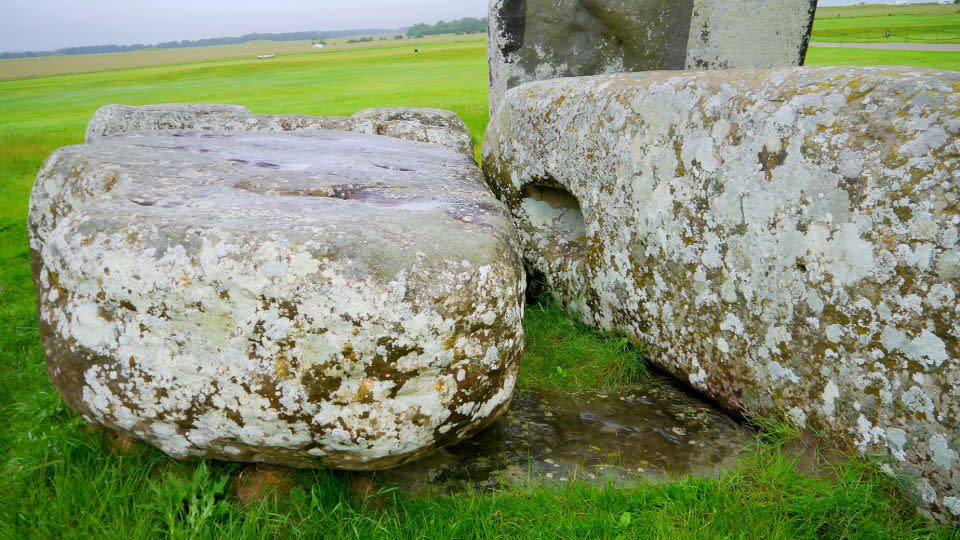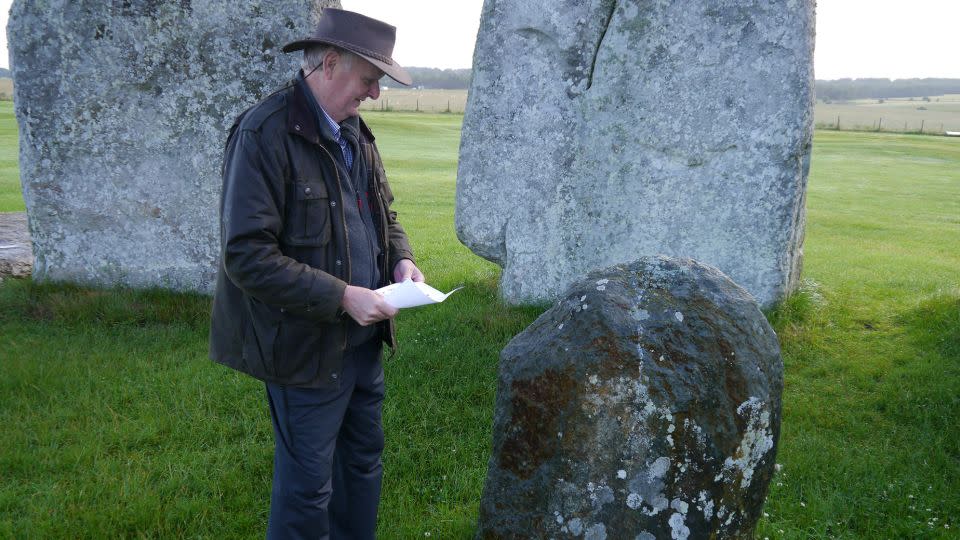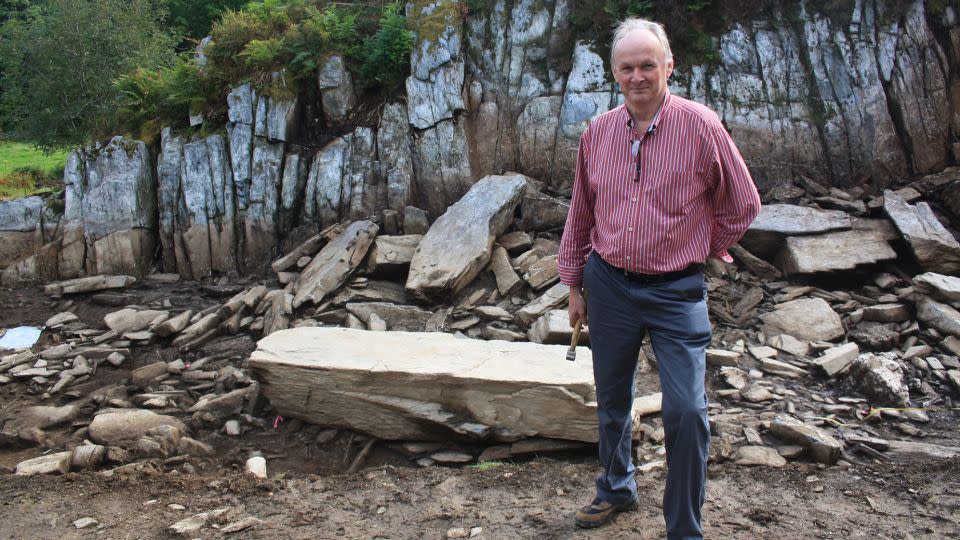Sign up for CNN’s Wonder Theory science newsletter. Explore the universe with news about fascinating discoveries, scientific advances and more.
Stonehenge’s Altar Stone, located at the heart of the ancient monument in southern England, may have been transported more than 700 kilometres (430 miles) from the site in what is now northeastern Scotland around 5,000 years ago, according to new research.
The findings of a new study published Wednesday in the journal Nature refute a centuries-old idea that the Altar Stone originated in modern-day Wales. The largest bluestone used to build Stonehenge, the Altar Stone is a thick block weighing 13,227 pounds (6 metric tons) and is located at the center of the circle of stones.
“This stone has travelled an incredibly long distance – at least 700km – and this is the longest recorded journey for any stone used in a monument at that time,” study co-author Nick Pearce, a professor in the department of geography and earth sciences at Aberystwyth University in Wales, said in a statement. “The distance travelled is astonishing for the time.”

The study’s authors said the research directly addresses one of Stonehenge’s many mysteries and also opens up new ways to understand the past, including connections between Neolithic people who left no written records.
According to researchers, construction of Stonehenge began as early as 3000 BC and took place in several stages. The Altar Stone is thought to have been placed within the central horseshoe during the second construction phase, between 2620 and 2480 BC.
The study’s authors wrote that the discovery of the stone’s origins showed that ancient Britain and its people were much more advanced and were likely capable of moving large stones by sea.
Unlocking ancient secrets
Significant research has been carried out over the years focusing on the types of stone used to build the iconic circle in Wiltshire, with previous analysis suggesting that bluestones, a type of fine-grained sandstone, and blocks of silicified sandstone called sarsen were used in the monument’s construction. The landmark is located at the southern end of Salisbury Plain, which was inhabited between 5,000 and 6,000 years ago.
The sarsens come from the Western Woods near Marlborough, about 15 miles (25 kilometers) away, while some of the bluestones come from the Preseli Hills area of West Wales, thought to be the first stones to be placed in the area. Although researchers have put the Altar Stone in the same category as the bluestones, its origins have remained a mystery until now.
“Our discovery of the origin of the Altar Stone reveals significant levels of social coordination in the Neolithic period and helps paint a fascinating picture of prehistoric Britain,” Chris Kirkland, co-author of the study and professor and leader of the Mineral Systems Time Scales Group in the School of Earth and Planetary Sciences at Curtin University in Australia, said in a statement.
“Transporting such a large load overland from Scotland to southern England would have been extremely challenging, suggesting a possible maritime shipping route along the British coast. This suggests long-distance trade networks and a higher level of social organisation than is commonly thought to have existed in Britain during the Neolithic period.”


To better understand the origin of the Altar Stone, researchers analyzed the age and chemistry of mineral grains recovered from fragments of the stone.
The analysis revealed the presence of zirconium, apatite and rutile grains in the fragments. The zirconium was determined to be between 1 billion and 2 billion years old, but the apatite and rutile grains were determined to be between 458 million and 470 million years old.
Lead study author Anthony Clarke, a PhD student in the Time Scales of Mineral Systems Group within Curtin’s School of Earth and Planetary Sciences, said the team used analysis of the ages of mineral grains to create a “chemical fingerprint” that could be compared with sediments and rocks across Europe. The grains were best matched to a group of sedimentary rocks known as Old Red Sandstone, found in the Orcadian Basin in north-east Scotland, which is completely different from the rocks found in Wales.
“Given the technological constraints of the Neolithic era, the findings raise fascinating questions about how such a large stone was transported over such great distances around 2600 BC,” Clarke said.
The discovery was also a personal one for Clarke, who grew up in the Preseli Hills in Wales, where some of Stonehenge’s stones originated.
“I first visited Stonehenge when I was 1 year old and I’m now 25. I’ve come back from Australia to help make this scientific discovery; I’ve come full circle with the circle of stones,” Clarke said.


However, the determination that the Altar Stone came from the region known today as Scotland raises many new questions.
“It’s exciting to know that our chemical analysis and dating work has finally solved this great mystery,” study co-author Richard Bevins, an honorary professor in the department of geography and earth sciences at Aberystwyth University, said in a statement. “The hunt will continue to pinpoint exactly where in north-east Scotland the Altar Stone comes from.”
Joshua Pollard, professor of archaeology at the University of Southampton, described the find as “a fantastic result”. Pollard was not involved in the research.
“The science is good,” Pollard said. “This is the team that has been active in successfully procuring the smaller Stonehenge bluestones using a fairly sophisticated set of techniques.”
Moving large rocks
Today, the Altar Stone lies broken on the ground, with two stones from the collapsed Great Trilithon structure resting on it. A trilithon is a pair of vertical stones with a horizontal stone above them. Stonehenge’s horseshoe shape contains five trilithons, but the Great Trilithon was aligned with the solstice axis, so that on the winter solstice the sun appeared to set between the stones.
However, researchers question whether the Altar Stone once stood upright and what purpose it once served.
“One suggestion is that stone bore witness to the dead, and so Neolithic people built stone circles as part of their ancestor-respecting rituals,” Bevins said.
Pollard referred to the Altar Stone as “an anomaly lying in what should be the most sacred place within the monument.”


So how exactly did the massive Altar Stone end up on Salisbury Plain?
The study’s authors said Britain at the time was covered in forests and other impassable geographic features, making it incredibly difficult to transport the stone by land. But a sea route could have allowed sea transport, Clarke said.
“Incredible as it may seem, Stonehenge itself is an incredible monument,” Pollard said. “Increasingly, it appears that the stones were sourced from the ancestors of those who created Stonehenge — it condenses historical genealogical stories into one place.”
Other examples of animals, artifacts and stone have been found in the study, suggesting that cargo could have been transported across open water during the Neolithic period, the authors wrote. Quarried stone tools have been found throughout Britain, Ireland and continental Europe, including a large stone grinding tool from Dorset, in what is now central Normandy.
There is also evidence that shaped blocks of sandstone were transported via rivers in Britain and Ireland.


“While our new, experimental research is not aimed at answering the question of how it got there – there are obvious physical barriers to transport by land, but if you go by sea it’s a difficult journey,” said Pearce. “There’s no doubt that this Scottish source shows a high level of social organisation in the British Isles at the time. These findings will have major implications for understanding societies, connectivity and transport systems in Neolithic times.”
The authors agree that some questions about Stonehenge may never be answered.
“We know why many ancient monuments were built, but the purpose of Stonehenge will always be unknown,” Clarke said. “And so we have to turn to the rocks. It’s an enduring mystery.”
For more CNN news and bulletins, create an account at CNN.com